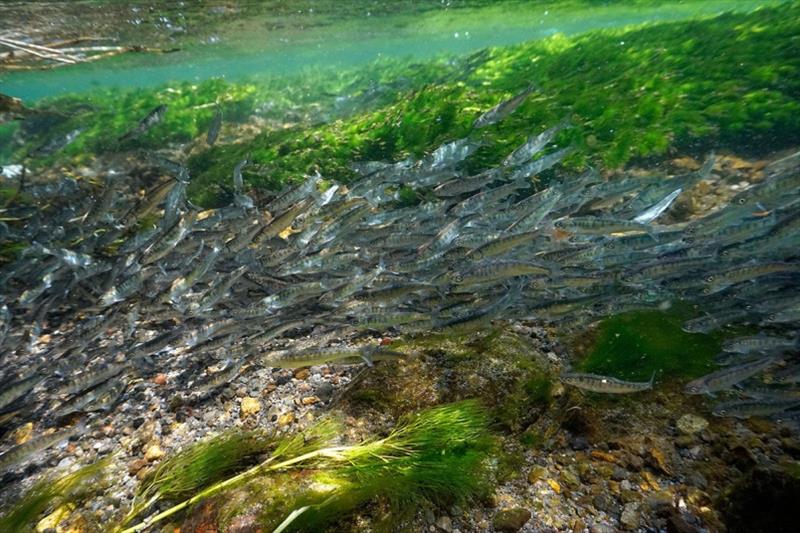
What is nearshore habitat and why does it matter to orcas?
by NOAA Fisheries 28 Jun 2020 15:14 UTC

Young salmon © NOAA Fisheries
There is an especially valuable environment in Puget Sound made up of the beaches, bluffs, inlets, and river deltas: the nearshore.
Nearshore habitat matters to Southern Resident killer whales because their primary prey, Chinook salmon, need them to grow and find safety when they are young. Unfortunately, we have been losing these habitats in Puget Sound to industrial and residential development and agriculture.
Southern Resident Killer Whales eat salmon, primarily Chinook salmon. The whales search out and rely upon the ever-changing abundance of many different Chinook salmon runs up and down the Pacific Coast. Puget Sound Chinook salmon are one of the most important of these for the Southern Residents' recovery. Puget Sound Chinook salmon, however, are themselves threatened with extinction.
Killer whales eat Chinook salmon when the fish have grown into adults three years old and weighing close to 30 pounds. The salmon are headed back from the ocean through Puget Sound to their home rivers to lay their eggs. To make it to adulthood, though, these fish need to survive their adolescence as "juveniles" or "fry." That's where the nearshore zone comes in.
Tiny young Chinook salmon emerge from the gravel where they hatched from eggs in the rivers of Puget Sound and the Salish Sea—the Skagit, Elwha, Nisqually, and others. Then the young fish follow one of several different strategies to grow as juveniles before heading out to the ocean. They can rear in the river and freshwater floodplains or head downstream to the great tidal river deltas. They can also head all the way out into Puget Sound looking for safety along the shore in pocket estuaries, kelp and eelgrass beds, coastal creeks, or lagoons.
"Restoring good habitat to support all of these different juvenile life history variations is really important for recovering salmon populations in Puget Sound," says Correigh Greene, Research Biologist with NOAA Fisheries' Northwest Fisheries Science Center.
Good habitat for juvenile Chinook salmon means hiding spots from predators, such as birds and other fish. It also means lots of space to grow without competition for food from other young salmon, explains Greene. "We need more Chinook salmon surviving the early life stages, making it through the gauntlet of predators," says Greene. Larger juveniles that have grown in rich rearing habitat have a better chance of avoiding predation.
Decades of profound alteration to the shorelines and estuaries of Puget Sound, however, has resulted in the loss and degradation of these habitats. They no longer provide enough safety and space for juvenile salmon. We have drained tidal deltas for agriculture, developed industrial ports and marinas, and armored our beaches, reducing the food they contribute to nearshore ecosystems. More than 30 percent of the Puget Sound shoreline has bulkheads or other "hard armor" instead of a natural waterfront. This data comes from Shore Friendly, a collaboration between Washington State Departments of Fish and Wildlife and Natural Resources and the U.S. Environmental Protection Agency.
What are we doing to restore Nearshore Habitats?
Partners across Puget Sound are working to restore the nearshore environment on the massive, comprehensive scale that will make a difference.
The Puget Sound Nearshore Ecosystem Restoration Project coordinates with a range of government agencies, universities, tribes, and environmental organizations. They are working to bring restoration to many corners of the 2,500 miles of shoreline in Puget Sound. Washington State's Estuary and Salmon Restoration Program, is administering $10 million in funding for 24 projects across Puget Sound for 2019 to 2020. Projects will include:
- Removing levees along estuaries
- Removing armoring on beach shorelines to allow for lower-energy more natural beaches
- Restoring tidal channels through salt marsh that will provide foraging habitat and refuge for juvenile salmon
NOAA Fisheries has a special role in protecting and restoring nearshore habitat because it is so important to species listed under the Endangered Species Act. It is also crucial for fish stocks important to commercial, recreational, and tribal fisheries managed under the Magnuson-Stevens Act. We review actions by other federal agencies that affect nearshore habitat and helpthem find ways to offset, or mitigate, the effects of those actions.
NOAA Fisheries also supports salmon habitat restoration through its Restoration Center and by administering the Pacific Coastal Salmon Recovery Fund. These programs invest millions of dollars a year in restoring nearshore habitat, especially in estuaries that are especially important to Puget Sound Chinook salmon. We work with partners, such as the National Fish and Wildlife Foundation. We use the latest science to focus restoration funding where it will do the most good for Southern Resident killer whales.
In the coming weeks, we will share examples of successful nearshore restoration occurring around Puget Sound and what you can do to help.
Southern Resident Connections
Southern Resident killer whales are icons of a vibrant but struggling marine ecosystem that is important to us all. Join us in exploring the ecological connections that tie this system together, and the ways we are protecting and working to recover the whales we all care so much about.
Read more entries